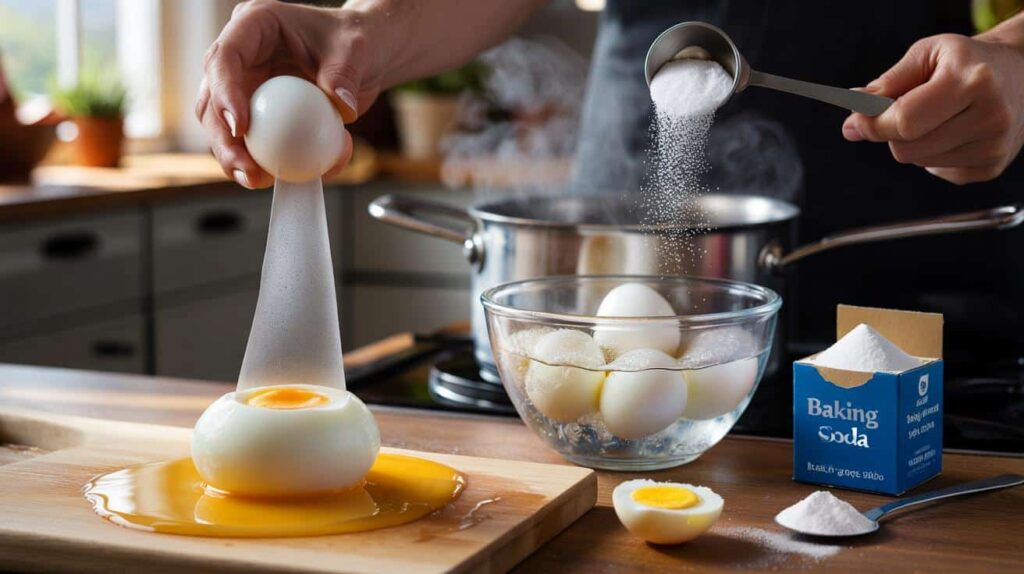Eggshell fragments stuck like sparkles after a celebration, and the white tore in uneven crescents. For the second egg, I attempted to peel it under running water. No success. By the third, breakfast had transformed into a disaster scene. A neighbor once insisted there was a one-ingredient solution. A pantry hack you’d forget until the morning you truly needed it. I poured myself some coffee, gazed at the pot, and reached for a small blue box I use to freshen my fridge. The water hissed. The eggs floated. The kitchen fell silent. The shell came off in one, smooth motion. A small chemical push had altered everything.
The tiny chemistry that frees the shell
Boiling eggs with baking soda isn’t just a trend. It’s a matter of pH. Fresh egg whites are slightly acidic, which causes the proteins to cling tightly to the eggshell’s inner membrane as soon as heat is applied. Baking soda raises the water’s pH into a more alkaline range. This change weakens the bond between the albumen and the membrane, allowing the shell to detach instead of sticking like Velcro.
During a hectic brunch shift, I observed a line cook testing two pots side by side. Identical eggs, identical timing. One pot contained plain water. The other had a teaspoon of baking soda swirling in a vigorous boil. When the timer sounded, he tapped each egg, rolled it gently, and peeled. The regular batch resulted in pitted whites and soft curses. The baking soda batch peeled off in large sheets, almost dramatic. *The shell nearly fell away.*
Here’s the reasoning in simple terms. As eggs age, they naturally lose carbon dioxide through the shell, which raises the pH of the whites and makes them simpler to peel. Baking soda simulates that “older egg” environment on demand. The alkaline water seeps through tiny pores in the shell, reducing the stickiness of the inner membrane. Heat does the rest: proteins set, but they don’t bond so tightly to the shell. **Baking soda alters the pH of the cooking water, and that changes everything.**
The exact method, step by step
Use 1 teaspoon of baking soda for every quart (liter) of water. Bring the water to a vigorous boil, then gently lower cold eggs from the fridge using a spoon. Maintain a steady boil. Cook for 7–8 minutes for soft centers, 10–12 for classic hard-boiled. While they simmer, prepare an ice bath. When the timer goes off, transfer the eggs directly into that cold shock for 5–10 minutes. Peel them under a gentle stream of water, starting at the wider end where the air pocket is located.
Small actions lead to significant results. Crack the egg all over, not just in one area, then roll it under your palm to loosen the delicate membrane. Start peeling from the wide end so water can flow between the layers. If you cook a dozen, peel them while they’re still slightly warm from the ice bath—if they’re too cold, the membrane tightens again. And yes, begin with clean eggs; bits of straw or chalky bloom on backyard eggs act like glue in boiling water. Let’s be honest: nobody actually does that every day.
We’ve all experienced that moment when a perfect picnic plan is ruined by torn deviled eggs. This trick gives you back your afternoon. **Fresh eggs stick because they’re acidic; older eggs peel easily because they’re not.** That one line saves a lot of frustration.
“Raise the pH, release the bond — that’s all there is to it.”
- Effective ratio: 1 teaspoon baking soda per quart/liter.
- Start hot: place cold eggs into boiling water, not cold starts.
- Ice bath is important: shock for at least 5 minutes.
- Peel under water: begin at the wide end, following the membrane.
What this means for your everyday cooking
This small adjustment unlocks more than just neat shells. It builds confidence. When you can rely on a clean peel, you can confidently prepare weeknight Cobb salads and Sunday deviled eggs without hesitation. You can purchase fresh, local eggs without incurring the “sticky shell tax.” You spend less time worrying and more time enjoying. **Add the soda to the water, not to the egg.** The method is minor, but it’s a nudge that leads to better packed lunches, smoother meal preparation, more relaxed hosts, and happier guests who notice when the whites are silky-smooth and the yolks gleam like a sunset.
| Key Point | Detail | Benefit for the Reader |
|---|---|---|
| Alkalinity breaks the bond | Baking soda raises water pH, loosening the membrane | Peels come off in larger sheets, fewer imperfections |
| Start hot, finish cold | Boiling start plus ice bath contracts egg white | Cleaner edges, tender texture, less tearing |
| Correct ratio | 1 tsp baking soda per quart/liter of water | Consistent results without uncertainty |
FAQ :
- Does baking soda alter the taste of the eggs?A small amount won’t make them taste soapy. Stick to about 1 teaspoon per quart/liter and you’ll only notice the easier peeling.
- Is salt or vinegar superior to baking soda?Salt can help season and elevate the boil, vinegar acidifies and firms up whites if they crack, but acidic water often makes peeling more difficult. For easy peeling, alkaline is the winner.
- Should I begin eggs in cold water or boiling water?For this method, start in boiling water. The quick setting at the surface helps prevent the white from bonding tightly to the shell.
- How long should I chill in the ice bath?Five minutes minimum. Up to ten for a complete set and easy handling. The shock helps the white separate from the membrane.
- What if my eggs are very fresh from the farm?Use the baking soda, maintain the ratio, and peel under running water. If they’re ultra-fresh, give them an extra minute in the ice bath to relax the membrane.








